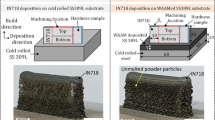Abstract
When metal is removed by machining there is substantial increase in the specific energy required with decrease in chip size. It is generally believed this is due to the fact that all metals contain defects (grain boundaries, missing and impurity atoms, etc.), and when the size of the material removed decreases, the probability of encountering a stress-reducing defect decreases. Since the shear stress and strain in metal cutting is unusually high, discontinuous microcracks usually form on the metal-cutting shear plane. If the material being cut is very brittle, or the compressive stress on the shear plane is relatively low, microcracks grow into gross cracks giving rise to discontinuous chip formation. When discontinuous microcracks form on the shear plane they weld and reform as strain proceeds, thus joining the transport of dislocations in accounting for the total slip of the shear plane. In the presence of a contaminant, such as CCI4 vapour at a low cutting speed, the rewelding of microcracks decreases, resulting in decrease in the cutting force required for chip formation. A number of special experiments are described in the paper that support the transport of microcracks across the shear plane, and the important role compressive stress plays on the shear plane. Relatively recently, an alternative explanation for the size effect in cutting was provided based on the premise that shear stress increases with increase in strain rate. When an attempt is made to apply this to metal cutting by Dineshet al (2001) it is assumed in the analysis that the von Mises criterion pertains to the shear plane. This is inconsistent with the experimental findings of Merchant. Until this difficulty is taken care of, together with the promised experimental verification of the strain rate approach, it should be assumed that the strain rate effect may be responsible for some notion of the size effect in metal cutting. However, based on the many experiments discussed here, it is very unlikely that it is totally responsible for the size effect in metal cutting as inferred in Dineshet al (2001).
Similar content being viewed by others
References
Anderson T L 1991Fracture mechanics (Boca Raton, FL: CRC Press)
Argon A S, Im J, Safoglu R 1975Metall. Trans. A6: 825
Backer W R, Marshall E R, Shaw M C 1952Trans. ASME. 74: 61
Barrett C S 1943Structure of metals (New York: McGraw Hill) pp 295
Blazynski T Z, Cole J M 1960Proc. Inst. of Mech. Eng. 174: 757
Bridgman P W 1952Studies in large plastic flow and fracture (New York: McGraw Hill)
Dinesh D, Swaminathan S, Chandrasekar S, Farris TN 2001Proc. ASME-Int. Mech. Eng. Conf. pp 1–8
Drucker D C 1949J. AppI. Phys. 20: 1
Ernst H J, Merchant M E 1941Trans. Am. Soc. Metals 29: 299
Eugene F 1952Ann. CIRP 52(1): 13–17
Eyring H, Ree T 1961Proc. Nat. Acad. Sci 47: 526–537
Eyring H, Jhon M S 1969Significant theory of liquids (New York: J Wiley and Sons)
Eyring H, Ree T, Harai N 1958Proc. Natl. Acad. Sci. 44: 683
Fleck N A, Muller G M, Ashby M F, Hutchinson J M 1994Acta Metall. Mater. 41: 2855
Gao H, Huang Y, Nix W D, Hutchinson J W 1999J. Mech. Phys. Solids 47: 1239
Heidenreich R O, Shockley W 1948Report on strength of solids (London: Phys. Soc.) p. 57
Kececioglu D 1958Trans. ASME 80:149–168, 541–546
Kececioglu D 1960Trans. ASME-J. Eng. Ind. 82: 79–86
Komanduri R, Brown R H 1967Metals Mater. 95: 308
Kwon K B, Cho D W, Lee S J, Chu C N 1999Ann. CIRP 47: 43–46
Langford G, Cohen M 1969Trans. Am. Soc. Metals 62: 623
Merchant M E 1945J. AppI. Phys. 16: (a) 267–275, (b) 318–324
Merchant M E 1950Machining theory and practice (Am. Soc. Metals) pp 5–44
Ma Q, Clarke D R 1995J. Mater. Res. 46: 477
Nix W D, Gao H 1998J. Mech. Phys. Solids 10: 853
Taylor G I 1934Proc. R. Soc. A145: 362
Piispanen V 1937Teknillinen Aikakaushehti (Finland) 27: 315
Piispanen V 1948J. Appl. Phys. 19: 876
Polanyi M 1934 Z.Phys. 89: 660
Shaw M C 1950J. Appl. Phys. 21: 599
Shaw M C 1952J. Franklin Inst. 254/2: 109
Shaw M C 1980Int. J. Mech. Sci. 22: 673–686
Stelmashenko N A, Walls M G, Brown L M, Milman Y V 1993Acta. Metall. Mater. 41: 2855
Taniguchi N 1994Precision Eng. 16: 5–24
Orowan E 1934Fatigue and fracture of metals (New York: John Wiley & Sons)
Usui E, Gujral A, Shaw M CInt. J. Machine Tools Res. 1: 187–197
Vyas A, Shaw M C 1999Trans. ASME J. Mech. Sci. 121: 163–172
Walker T J 1967 PhD dissertation, Carnegie-Mellon University, Pittsburg, PA
Walker T J, Shaw M C 1969Advances in machine tool design and research (Oxford: Pergamon) pp 241–252
Zhang B, Bagchi A 1994Trans. ASME-J. Eng. Ind. 116: 289
Author information
Authors and Affiliations
Rights and permissions
About this article
Cite this article
Shaw, M.C. The size effect in metal cutting. Sadhana 28, 875–896 (2003). https://doi.org/10.1007/BF02703319
Issue Date:
DOI: https://doi.org/10.1007/BF02703319




